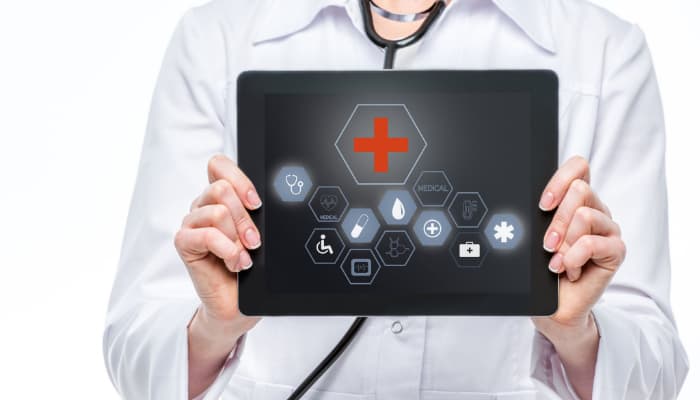By Dr. Darren Schulte
In the early days of the COVID-19 pandemic, U.S. healthcare providers saw a dramatic spike in telemedicine visits. Telemedicine technology emerged as a valuable service offering access to care during a time when many people, especially those in COVID high-risk groups, were wary of going to the clinic or the urgent care center. While historically offered primarily for patient convenience for common, episodic care like earaches, upper respiratory infections and skin rashes, telemedicine presented a vital connection when there weren’t any other options for care in the midst of the pandemic lockdown.
Over the past few months we’ve seen the loosening of restrictions and insurance purse strings, which have allowed telemedicine offerings to expand significantly. Telemedicine now offers care nearly on-par with in-person treatment for some conditions, particularly in mental health. And some companies are now offering primary care via telemedicine that goes beyond typical episodic care like surgical follow-up and chronic disease management.
As states and municipalities are re-opening, virtual visits are on the decline. It is not surprising that some patients are returning to the office, clinic or hospital for care since the face-to-face visits remain as preferential. Additionally, many insurance companies now require that patients pay some co-payments (unlike the initial days of COVID). Physicians are reimbursed at a lower rate for telemedicine relative to in-person encounters. While some patients have moved back to in-person visits for ambulatory care services, there is a concern that some are deferring or delaying care. If this is the case, we could see a worsening of disease and potentially avoidable events.
Improving the patient and provider telemedicine experience
During a typical in-person visit, the physician spends more than 16 minutes using the electronic health record (EHR) system. This is time spent with their head down, clicking away, reviewing charts, typing in required data, taking notes and entering orders and billing codes. Clearly this detracts from the patient-physician connection, but the awkwardness might even be more pronounced with a telemedicine encounter. With a camera trained directly on their face, the physician needs to keep their eyes fixed forward looking at the camera/patient. Otherwise it feels as though their attention is elsewhere. Of course, this makes it more difficult to consult and digest the EHR in real-time.
To solve that problem, many telemedicine companies offer their own documentation management system rather than relying upon a third-party EHR vendor system. This enables physicians to use a split screen, making the patient data available to consult during the visit while keeping the physicians eyes trained on the patient. With some user configuration, a third-party EHR can sometimes even be set up to show alongside the patient view but this creates a unique set of challenges. Legacy EHR systems were designed for an in-person workflow, not a telemedicine visit.
Gaps in workflow and siloed data
Regardless of the setup, both scenarios create gaps in the physician’s workflow and the patient’s data. Some telemedicine solutions now offer remote monitoring and data gathering before and during the visit, allowing physicians to be more engaged in the conversation. But these don’t always integrate with the EHR system of record. That means telemedicine data may be left off the patient’s EHR or it must be entered separately. This creates more work and introduces the risk of entry error.
Worse yet, if more than one provider is involved in the patient’s care, it could be extremely difficult to keep everyone on the same page. Critical issues could be missed. The cough that appears to be an infection might actually be a side effect of a medication unknown to the telemedicine physician. Or the skin lesions might be a symptom of an autoimmune disorder, not an allergic reaction.
EHR-telemedicine integration is key for patient outcomes
There’s a tremendous opportunity to substantially improve the quality of telemedicine care and provider-patient interactions with a seamless, intelligent EHR integration. By pre-digesting and summarizing patient data from the EHR into a succinct briefing, providers could have more informed and insightful telemedicine conversations with their patients.
Using machine learning technology that can automatically mine text-based EHR data and assemble an easy-to-navigate longitudinal view of patient care would allow physicians to make best of the virtual visit. Incorporating voice commands that trigger automatic queries of patient data can elicit information that is pertinent to the discussion. For example, a prompt-less “Ask Alexa” type of feature that listens for cues during a conversation and automatically serves up useful, relevant data could be especially powerful. It provides relevant information to enhance the physician’s assessment of the case all while allowing them to remain engaged in the patient interaction.
Certainly, telemedicine will not suffice for every type of visit or every patient. However, integrating medical records with virtual visit technology and leveraging intelligent machine learning solutions to surface real-time insights gives providers a much more holistic view of patient needs and potential risks. That means a better patient-provider relationship, richer interactions and ultimately, improved patient outcomes.
Dr. Darren Schulte, MD is CEO of Apixio.
The Editorial Team at Healthcare Business Today is made up of skilled healthcare writers and experts, led by our managing editor, Daniel Casciato, who has over 25 years of experience in healthcare writing. Since 1998, we have produced compelling and informative content for numerous publications, establishing ourselves as a trusted resource for health and wellness information. We offer readers access to fresh health, medicine, science, and technology developments and the latest in patient news, emphasizing how these developments affect our lives.








